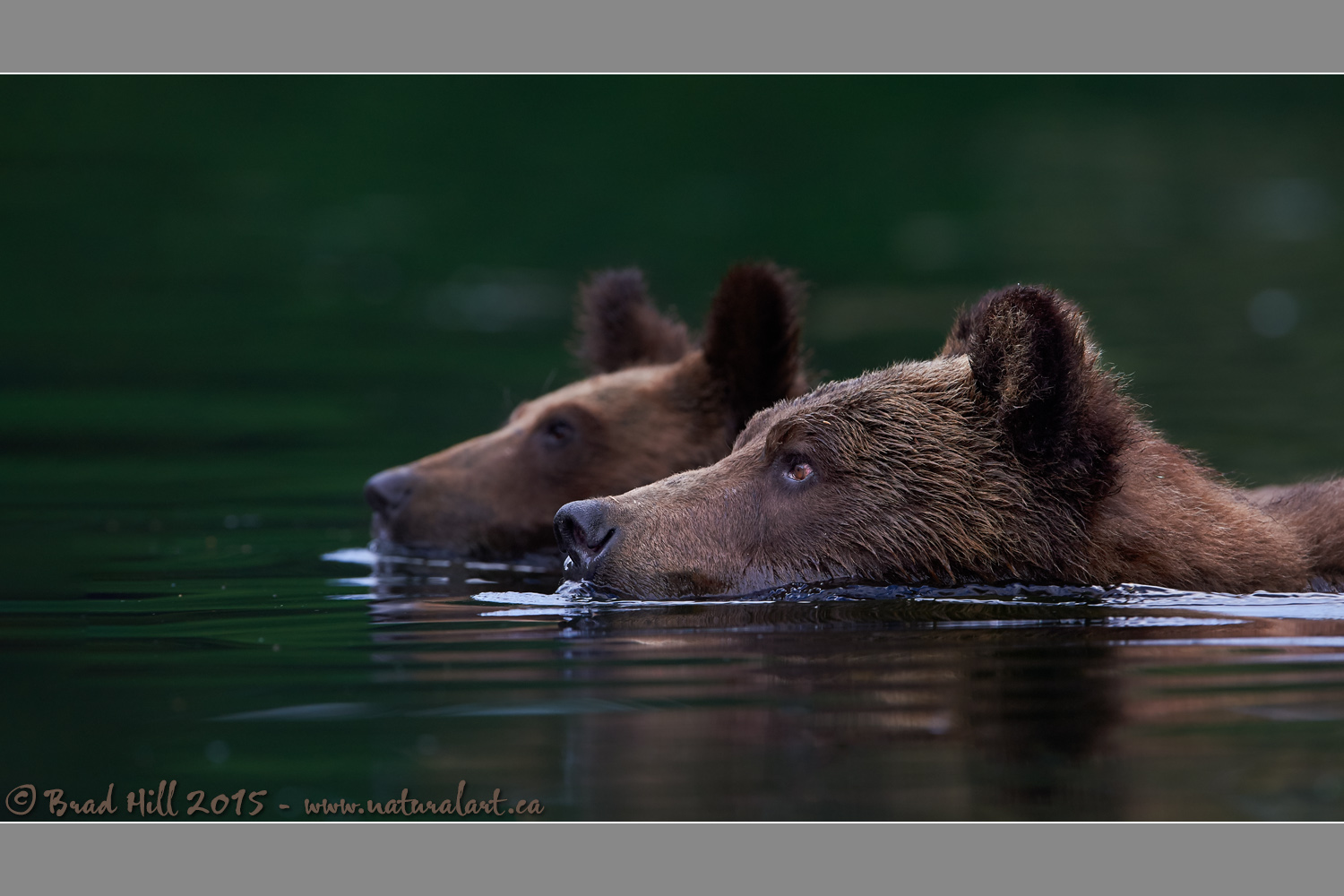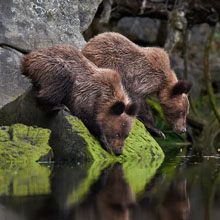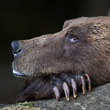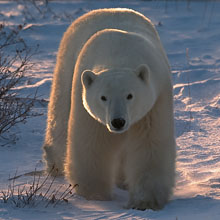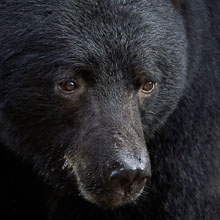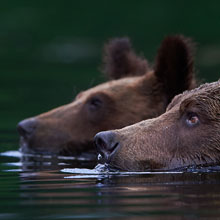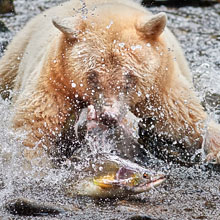Availability: Undetermined - Enquiries?
In the Field
Full STOP - Threat Sensed. Khutzeymateen Grizzly Sanctuary, northern BC coast, Canada. May 31, 2013.
This was a moment I'll remember for a long time. We had been watching this female grizzly and her two cubs foraging on the edge of a channel in the Khutzeymateen estuary when the three of them apparently decided the grass was greener (and tastier) on the other side of the channel. At the time the tide was rising and was approaching its highest point, and had functionally stopped the flow of the river, producing calm waters. The three bears chose to swim a route that brought them quite close to our boat. Just as they were passing us both mom and the cub swimming beside her stopped swimming and went into "all sensors deployed" mode - with their erect ears, focused eyes, and collective noses all pointing at the distant shore. When I captured this shot the bears had pretty much stopped their forward motion, but the incoming tidal current still produced a small standing wave in front of their noses and ripples along the sides of their faces. After I had captured a few swimming-in-profile shots I looked along the bears eye-lines and, sure enough, saw another bear walking in our direction, though at the time it was hundreds of meters away (but obviously close enough to cause these two bears some concern).
I captured this shot with a fairly long telephoto lens - a 600mm f4. Like with any shot, and especially when hand-holding a big lens from an unstable surface, I had to try to "optimize" this shot by balancing the variables of shutter speed, aperture, and ISO. The subjects were quite close to me and, even though they were close together, I knew it was absolutely impossible to render both subjects sharply (regardless of the aperture I chose). So I stopped down enough to get Ma totally in focus (f8) with the intent of her becoming the first thing the viewer's eye would go to (owing to how sharply she was rendered). Even at this aperture I was pushing it a bit in terms of shutter speed (1/400s) when hand-holding the 600mm lens, but past experience and testing had taught me that the odds were better than 50:50 that the capture would be sharp. Even at this moderate shutter speed I needed a reasonably high ISO (3600) to get the exposure right...but I was confident that at this ISO I had enough dynamic range and tonal range to render the image as I wanted, and that noise would not be an issue at all.
Did I choose the right balance of exposure variables to get the shot "right"? I think from a technical perspective the answer is probably yes. But what about the creative side of the equation? This is much tougher to answer. Working up-close with multiple subjects always presents focus and depth-of-field challenges, especially when you have a 600mm lens in your hands and no time to change lenses! I briefly considered focusing on the background cub and throwing Ma out of focus, but quickly decided that with her physical overlap of (and interference with the sight of) the cub she'd simply end up being a major distraction to the composition. But when I focused on the closer of the two bears (mom), I saw some symmetry in their poses and it occurred to me that the symmetry might help convey the short story behind the image. Moreover, because I was aware of the normal hierarchy of eye-drawing power in an image (first to luminance, second to the sharpest portion of the images, third to colour differences) I was fairly sure that the eyes of anyone viewing the image would be drawn first to the sharply focused mom - and likely to the white of her eye - and then slowly they'd explore the rest of the image. I can't say for sure that I'm right here - these are simply the things I was considering while peering through the viewfinder...
For the pixel-peepers of the wildlife photography world - here's a 2400 pixel detail for your perusal:
• Full STOP - Threat Sensed: Download 2400 pixel image (JPEG: 0.9 MB)
NOTES:
1. This image - in all resolutions - is protected by copyright. I'm fine with personal uses of them (including use as desktop backgrounds or screensavers on your own computer), but unauthorized commercial use of the image is prohibited by law. Thanks in advance for respecting my copyright!
2. Like all wildlife images on this website, the subject is fully wild and completely unconstrained. Besides the potential impact of my presence, nothing has been done to intentionally alter or affect the ongoing behavior of the subject and, of course, there has been no use of any form of bait or other form of wildlife attractants (including vocalizations).
3. This image was captured during one of my two spring "Grizzlies of the Khutzeymateen" photo tours in May/June of 2013. Each year I offer trips into two different parts of the Great Bear Rainforest as well as one to photograph aquatic mammals and oceanscapes near the northern tip of Vancouver Island. And, in selected years, I also offer photo tours to locations to capture other highly sought-after subjects, such as various boreal owl species and wildlife of Canada's Arctic. Details about these trips can be found on the Photo Tours page of this website.
Behind the Camera
Full STOP - Threat Sensed. Khutzeymateen Grizzly Sanctuary, northern BC coast, Canada. May 31, 2013.
Digital Capture; Compressed RAW (NEF) 14-bit format; ISO 3600.
Nikon D4 paired with Nikkor AF-S 600mm f4 VR - hand-held from floating Zodiac. VR on in Normal mode.
1/400s @ f8; -0.67 stops compensation from "recommended" matrix-metered exposure setting.
At the Computer
Full STOP - Threat Sensed. Khutzeymateen Grizzly Sanctuary, northern BC coast, Canada. May 31, 2013.
RAW Conversion to 16-bit TIFF Phase One's Capture One Pro 8. Three raw variants (different versions of a single raw capture) processed, differing by a total of 1.4 stops in exposure.
Further digital corrections on resulting 16-bit TIFF files using Adobe's Photoshop CC 2014 and Light Crafts Lightzone. Photoshop adjustments included compositing (blending) of the three output files from the raw converter using manual masking techniques, minor exposure and contrast tweaks, selective colour desaturation, and selective sharpening for web output. Final tone-tweaking performed using LightZone's "tonemapper" tool.
Conservation
Full STOP - Threat Sensed. Khutzeymateen Grizzly Sanctuary, northern BC coast, Canada. May 31, 2013.
Ten percent of the revenue generated by this image will be donated to Raincoast*.
Species Status in Canada**: Special Concern (May 2002).
While Grizzly Bears (Ursus arctos) are not technically listed as "Endangered" in Canada, they have been extirpated from most of their historical range. Grizzly Bears are far more sensitive to intrusion/disturbance in their habitat than are Black Bears and are being increasingly forced into marginal habitat by human encroachment. The Great Bear Rainforest along the central and northern coast of British Columbia is one of the last strongholds of the Grizzly Bear in Canada, and even this population is coming under increasing pressure.
On December 18, 2017 the government of British Columbia banned grizzly hunting across the entire province. This major conservation victory came after decades of tireless work by many dedicated conservationists and ecologists and, most importantly, it reflects the opinion of the vast majority of British Columbians. And, it means that AT LEAST while the current government remains in power grizzlies are finally "safe" in British Columbia.
Now that we've at least temporarily won the battle to save grizzlies in BC, it's time to re-focus our efforts toward protecting ALL of BC's carnivores, including Gray Wolves, Black Bears, Cougars, Wolverines, and more! Simply put, there are no ecological, economic, or ethical arguments supporting the trophy hunting of carnivores.
In a great first step towards ending the hunting of carnivores throughout BC the Raincoast Conservation Foundation has developed a program designed to protect ALL carnivores within the Great Bear Rainforest. Details about this program can be found on this page on Raincoast's website. Check it out and, better yet, make a donation to help Raincoast purchase the remaining commercial hunting tenures in the Great Bear!
*The Raincoast Conservation Society (and Foundation) is an effective and efficient organization that has been fighting for protection of this unique habitat. If you are looking for a meaningful way to contribute to the conservation of this amazing ecosystem, Raincoast will provide maximal "bang" for your conservation dollars.
**as determined by COSEWIC: The Committee on the Status of Endangered Wildlife in Canada












